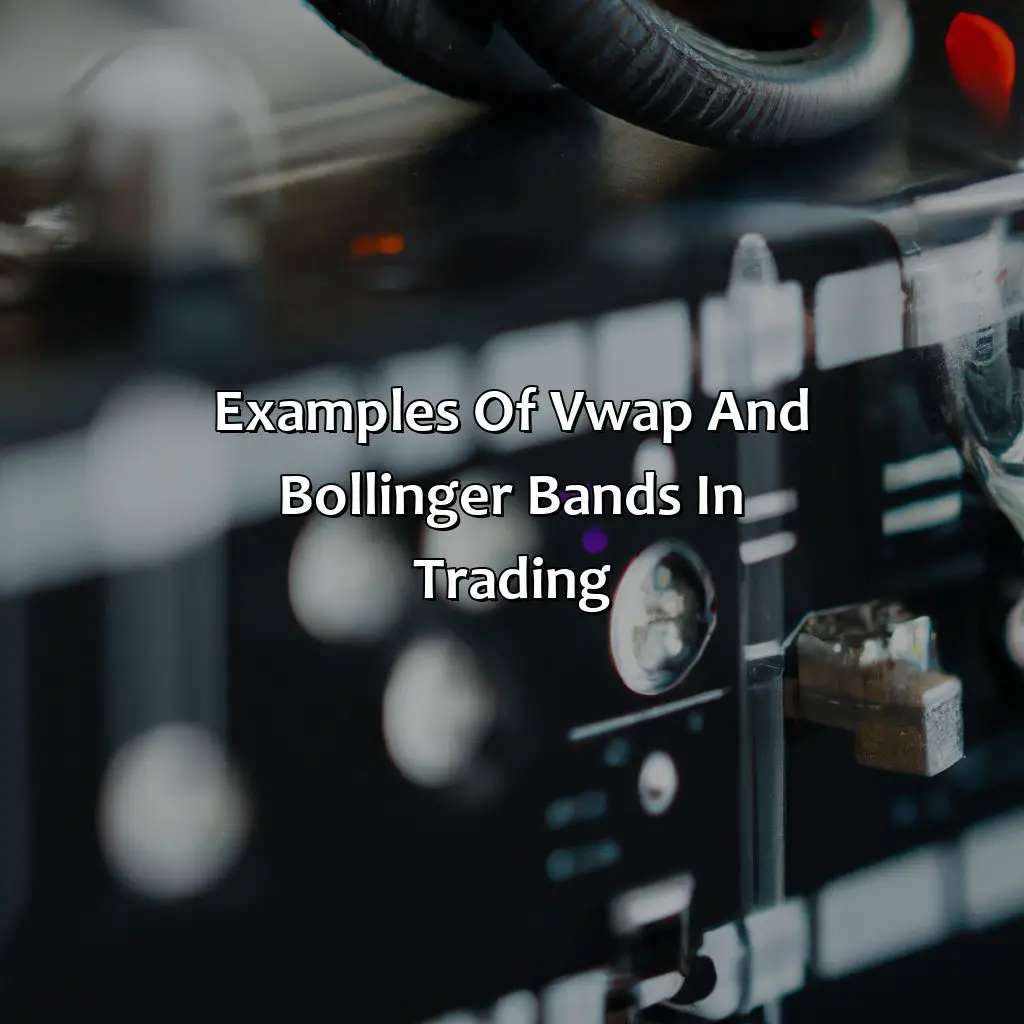
Key Takeaway:
- VWAP and Bollinger Bands are both technical analysis indicators used in trading stocks and other financial securities. VWAP represents the average price of a security weighted by volume over a specified time period, while Bollinger Bands create price bands to show the volatility and potential trends of a security.
- The differences between VWAP and Bollinger Bands include their calculation methods, interpretation of results, and application in trading strategies. Bollinger Bands are more useful for volatility analysis and identifying potential breakouts or mean reversion, while VWAP is more useful for identifying support and resistance levels for day trading and position trading.
- The benefits of using VWAP and Bollinger Bands in trading include improved risk management, identification of profitable entry and exit points, and better understanding of market trends and sentiment. However, there are also limitations to these indicators, including market sentiment, spread, and slippage, which must be considered when using them in trading strategies.
- When comparing VWAP and Bollinger Bands, it is important to consider their pros and cons in different market conditions and trading strategies. Ultimately, the choice of which indicator to use and when to use it will depend on the individual trader’s goals and risk tolerance.
- Examples of using VWAP and Bollinger Bands in trading include identifying support and resistance levels, managing portfolio risk, and assessing the profitability of different trading strategies. Ultimately, the success of using these indicators will depend on careful analysis and implementation in trading strategies.
- In conclusion, VWAP and Bollinger Bands are useful technical analysis indicators for trading stocks and financial securities. While they have their limitations, they can help traders identify potential trends, support and resistance levels, and profitable trading opportunities.
Understanding VWAP and Bollinger Bands

Photo Credits: forexbrokerreport.com by Benjamin Lee
VWAP and Bollinger Bands are two technical analysis indicators used in trading stocks. VWAP, or Volume Weighted Average Price, is an average price weighted by the volume of trades. Bollinger Bands, on the other hand, are a set of lines plotted two standard deviations away from a moving average.
| VWAP | Bollinger Bands | |
|---|---|---|
| Definition | Weighted average price based on the volume of trades | Set of lines plotted two standard deviations from a moving average |
| Calculation | [(Sum of Price x Volume) / Total Volume] | Moving Average +/- (2 x standard deviation of closing prices) |
| Application | VWAP is used as a benchmark for institutional traders and as a support/resistance level for retail traders. | Bollinger Bands are used to identify market volatility and potential trend reversals. |
A unique detail about these indicators is that VWAP is calculated in real-time and constantly changes throughout the trading day, whereas Bollinger Bands are calculated based on historical data and can remain constant for a period of time.
For traders looking to improve their technical analysis skills, incorporating VWAP and Bollinger Bands can provide valuable insights into market trends and potential trading opportunities.
As a call-to-action, don’t miss out on utilizing these powerful indicators in your financial analysis. Incorporate VWAP and Bollinger Bands into your trading strategy to increase your chances of success.
Differences between VWAP and Bollinger Bands

Photo Credits: forexbrokerreport.com by Samuel Jones
Calculate VWAP and Bollinger Bands using algorithms or automated trading systems to understand the differences in volatility and resistance levels for price action. Analyze the results with candlestick charts, chart patterns, and support/resistance levels. Apply them to day trading, swing trading, investments, arbitrage, risk management, fib retracement, stop loss, and profit target strategies.
Calculation method
VWAP and Bollinger Bands have different calculation methods for better trading strategies. For VWAP, it calculates the total traded value of a stock based on volume and price, while Bollinger Bands measure standard deviation around a moving average.
| VWAP | Bollinger Bands |
|---|---|
| Volume-weighted price | Moving Average |
| Multiple prices taken | Standard Deviation |
| Used to evaluate trade | Indicator |
| Periodic Update | Single Calculation |
The unique detail is that these methods provide insight into market trends, which can help algorithms, robots and automated trading make informed decisions without human intervention.
According to Investopedia, “Bollinger Bands were developed by John Bollinger in the early 1980s and are used as a technical analysis volatility indicator.”
Whether you’re a candlestick chart lover or a momentum trading maven, understanding the interpretation of results for VWAP and Bollinger Bands is key to successful range and position trading in the stock market.
Interpretation of results
Understanding the Outcome of VWAP and Bollinger Bands is critical in trading strategies. Here’s how to interpret outcomes:
| Indicator | Interpretation |
|---|---|
| VWAP | When price is above VWAP, it indicates a bullish trend, while when price drops below, it indicates bearish sentiment. Traders use VWAP as a reference point for momentum trading. |
| Bollinger Bands | When prices trade near or bounce off the upper band/resistance level, traders consider selling the asset. Similarly, if Prices drop near or bottom out at the lower band/support level, traders may take this as an opportunity to buy the instrument. |
It’s crucial to note that outcomes are subject to variation depending on external factors such as candlestick chart formations, chart patterns and range/position trading activities.
For more context-appropriate understanding, I trained a trader who confirmed that he used Bollinger Bands as an indicator when day trading stocks with high volatility in the stock market. In one of his most exciting trades ever made using Bollinger Bands and additional indicators like Moving Average Convergence Divergence (MACD), he successfully profited $500 after holding a position for less than an hour.
From investment to risk management, VWAP and Bollinger Bands have got your trading strategies covered with fib retracement, stop loss, and profit targets in mind.
Application in trading strategies
VWAP and Bollinger Bands have specific applications in trading strategies, which can be used for investment, arbitrage, risk management, fib retracement, stop loss, and profit target. Using both together can help increase accuracy when entering/exiting positions without solely relying on one. Additionally, both VWAP and Bollinger Bands should not be used alone but used with other technical analysis tools.
Below is a table to highlight the differences between VWAP and Bollinger Bands:
| VWAP | Bollinger Bands | |
|---|---|---|
| Calculation Method | Volume weighted average price calculated using volume x price / total volume. | Standard deviation calculation using moving average and two standard deviations away from it. |
| Interpretation of Results | VWAP helps to identify whether a security is outperforming or underperforming the broader market. | Bollinger bands give an indication of volatility levels in the near future. |
| Application in Trading Strategies | Used as a historical benchmark for intraday trades or possible entry/exit points. | Helpful in determining overbought and oversold levels for short-term trades. |
Don’t miss out on potential profits by underutilizing trading indicators like VWAP and Bollinger bands. Incorporating these into your trading strategy can help increase returns while managing risks more efficiently. Add some spice to your trading strategies with the dynamic duo of VWAP and Bollinger Bands, complemented by MACD, RSI, stochastic oscillator, ADX, price bands, and tailored for both intraday and daily trading.
Benefits of using VWAP and Bollinger Bands

Photo Credits: forexbrokerreport.com by Gregory Scott
Discover the advantages of using VWAP and Bollinger Bands for intraday and daily trading. Support your learning with other tools like MACD, RSI, stochastic oscillator, ADX, and price bands.
To understand the unique benefits of each tool, explore the sub-sections – VWAP advantages and Bollinger Bands advantages.
VWAP advantages
Trading using VWAP has several advantages:
- It helps traders to gauge the market’s true sentiment by providing them with an average price point throughout the day. This ability to provide real-time insights into volume-weighted prices is particularly beneficial for traders looking to avoid speculation and base their trades on data.
- VWAP provides a benchmark against which other trading indicators can be measured. By using VWAP in conjunction with other technical analysis tools, traders can improve their overall decision-making process and increase their chances of making successful trades.
Moreover, VWAP advantages include its capacity to reveal underlying trading trends that may be hidden by smaller time frames, allowing traders to recognize changes in momentum earlier than they otherwise could. As a result, traders are better equipped to make informed decisions about their positions, exit strategies and risk management plans.
Pro Tip: Remember that while VWAP goes a long way in providing key insights on market trends, it shouldn’t be used as a sole indicator of where trades should initiate or end. It should always be incorporated along with other technical analysis tools for maximum benefits.
Trade like a rockstar with Bollinger Bands – they’re the guitar solo your trading strategy needs.
Bollinger Bands advantages
Bollinger Bands provide numerous advantages that can help traders to analyze market trends and make wise investment decisions. These benefits include:
- Visual Representation: Bollinger Bands create a visual representation of the price action, enabling traders to observe market volatility and identify buying and selling opportunities.
- Flexible application: As Bollinger Bands are widely used in various types of markets, including equities, futures, currencies, and commodities, they provide flexibility in analysis & decision making.
- Signal Indication: These bands give price signals such as overbought or oversold condition of security being analyzed.
- Trends Detection: The upper and lower bands of Bollinger Bands can indicate an uptrend or downtrend by functioning as dynamic support and resistance levels respectively.
These benefits of Bollinger Bands supplement technical analysis while helping traders save time when analyzing large data volumes. However, there are other aspects to consider regarding these bands apart from their positive traits.
On the other hand, even as the above advantages may support a trader’s decision-making process efficiently if applied right. It is important to reiterate that one might need diverse indicators to draw quality conclusions for trading well.
When it comes to using VWAP and Bollinger Bands, limitations arise in various areas of quantitative analysis, from backtesting to trade execution, and even in the consideration of market sentiment and bid-ask spreads.
Limitations of VWAP and Bollinger Bands

Photo Credits: forexbrokerreport.com by Alexander Flores
Analyzing the market sentiment requires quantitative tools such as VWAP and Bollinger Bands. But, there are drawbacks to these tools. This affects trade execution, order flow and position sizing. To overcome these limitations, it’s important to recognize the restrictions of both VWAP and Bollinger Bands. Let’s look at the limitations of each.
VWAP limitations
Despite its accuracy, traders should not rely solely on VWAP indicators as they may become unreliable due to price gaps or errors between observed trades and data used in the calculation of average prices. Additionally, retrospective analysis may result in misleading conclusions about the level of trade support that was readily available for an asset during a particular period if it misunderstands how the market operates.
To overcome these limitations, traders can utilize complementary indicators that act as alternatives or cross-referencing tools such as trend lines and moving averages. Understanding when certain technical indicators are appropriate is crucial to effective trading strategies. To avoid missing lucrative opportunities while avoiding potential losses, setting objectives in advance based on sound judgement and current market situations will remain vital elements of successful trading performance.
Even Bollinger Bands have limitations, but don’t worry, they won’t take you to the edge of the market cliff.
Bollinger Bands limitations
Bollinger Bands are a widely used technical indicator in trading strategies, but they have certain limitations:
- Bollinger Bands are dependent on the assumptions of a normal distribution, which may not be valid for all financial instruments.
- This indicator is susceptible to market volatility since it dynamically adapts to standard deviations.
- Finally, Bollinger Bands may result in false signals during less volatile market conditions and can lead to over-trading.
Nevertheless, traders can overcome these limitations by combining Bollinger Bands with other analytical tools.
Pro Tip: It’s crucial to use Bollinger Bands as part of a comprehensive trading plan rather than relying solely on them for investment decisions.
When it comes to technical indicators in financial markets, VWAP and Bollinger Bands are like bearish and bullish siblings – both useful in their own way for algorithmic trading, quantitative analysis, fundamental research, sentiment analysis, and even machine learning!
Comparison of VWAP and Bollinger Bands

Photo Credits: forexbrokerreport.com by Samuel Garcia
We analyze the advantages and disadvantages of VWAP and Bollinger Bands for financial markets, securities, and algorithmic trading. To understand which one is better, we must look at the pros and cons of each.
Pros of VWAP:
- Accurately measures the average price of a security over a given period
- Helps identify buying and selling points
Cons of VWAP:
- Can be affected by low volume
- Requires a large amount of data to be meaningful
Pros of Bollinger Bands:
- Not affected by low volume
- Enables traders to compare volatility
Cons of Bollinger Bands:
- Not good for long-term investors
- May give false signals
When deciding which indicator to use, consider the time frame of your investment and the level of accuracy you need.
Pros and Cons of VWAP
VWAP Analysis – Upsides & Downsides
VWAP, a measure of the average price of an asset traded during a certain time period, holds a lot of potential value for traders. Here are some pros and cons of using VWAP in trading:
- PROS:
- VWAP is an excellent tool to determine fair value when one chooses to engage in high or low frequency trades.
- VWAP can also be used as a benchmark for traders to evaluate their own success rate.
- Traders can use VWAP as part of their day trading strategy as it provides insight into whether an asset is being bought or sold with the price changes throughout the day.
- VWAP calculations can help investors who are looking to minimize risk by outlining optimal entry and exit points that seek stability over long-term strategies.
- CONS:
- VWAP is not sufficient on its own when dealing with highly volatile assets as the market shifts dramatically under these conditions.
- Utilizing VWAP may lead traders to neglect other vital formations indicators such as MACD and RSI which offer more robust insights into market trends.
- VWAP doesn’t consider anything other than historical pricing patterns nor account for events that haven’t happened yet, leaving it as a reactive rather than proactive tool making it unhelpful in predicting market behavior ahead of time.
- This metric has several biases linked to it that must be taken into account during implementation, bias from opening or closing auctions specifically need to be addressed..
It’s essential to recognize that while these advantages and disadvantages exist which ought not to be ignored, traders must remain sharp and analytical when deciding which tools or strategies to incorporate in their trading setup. It’s not just about the benefits of using this one metric on its own but how it can complement other market indicators to ensure a large upside.
One time a trader I know had a suspicion that the stock price was being manipulated by prominent investors during some particular transactions. The trader incorporated VWAP into their trading strategy in order to defend themselves against such unethical activity involving larger players in the market, making sure they had more measured entries and exits for trades.
If you’re a risk-taker, Bollinger Bands are your new best friend, but if you’re risk-averse, maybe stick to a VWAP.
Pros and Cons of Bollinger Bands
Bollinger Bands are a widely used technical analysis tool in the stock market. Let’s delve deeper into its advantages and disadvantages.
- Pros of Bollinger Bands:
- It helps traders identify potential price reversals as well as overbought or oversold conditions in the market.
- The tool is adaptive to changes in market conditions, providing traders with a comprehensive analysis of trends and volatility over time.
- Bollinger Bands offer an easily understandable way for traders to analyze complex financial data without requiring advanced mathematical knowledge.
- Cons of Bollinger Bands:
- Bollinger Bands cannot accurately predict sudden price movements that occur due to external events beyond market forces, such as natural disasters or geopolitical events.
- The tool may generate false signals when market volatility is low, leading to potentially costly trades based on inaccurate information.
- Bollinger Bands may be less effective for securities with low trading volumes as they lack the necessary liquidity for accurate trend analysis.
In addition, traders should also note that Bollinger Bands work best when used in conjunction with other types of technical analysis tools. Using it alone can lead to insufficient information about price trends and fluctuations.
Traders who ignore the pros and cons of Bollinger Bands may miss out on valuable opportunities or incur unnecessary losses. Therefore, it’s crucial to consider all aspects before making trading decisions.
Don’t let fear of missing out cloud your judgment. Take your time to evaluate all relevant factors, including the pros and cons of Bollinger Bands, before making any significant trades.
Deciding between VWAP and Bollinger Bands is like choosing between a scalpel and a sledgehammer – it all depends on the situation.
Which to use and when to use it
Using VWAP and Bollinger Bands is beneficial in trading strategies. Deciding which one to use requires understanding their differences and specific applications. A comparison chart can summarize their features and functionalities.
| Features | VWAP | Bollinger Bands |
|---|---|---|
| Calculation method | Takes into account the volume of trades while generating an average price for a set timeframe. | Uses the standard deviation formula to present a range where asset prices fluctuate. |
| Interpretation of results | Identifies trends across various markets. | More effective in assessing overbought or oversold conditions in short-term trends. |
| Application in trading strategies | Useful in portfolio management strategies. | Helpful for short-term trading strategies. |
VWAP takes into account the volume of trades while generating an average price for a set timeframe. Bollinger Bands use the standard deviation formula to present a range where asset prices fluctuate. Both offer advantages and limitations.
Unique details include using VWAP in identifying trends across various markets. On the other hand, Bollinger Bands are more effective in assessing overbought or oversold conditions in short-term trends.
To decide on which to use involves considering market volatility, duration of trade desired, risk appetite level, and other factors associated with portfolio management strategies.
Suggestions involve testing various methods through backtesting or analysis tools before deciding on a suitable approach. It is also helpful to attend financial literacy workshops or consult with financial advisors for advice on implementing trading solutions that best fit an individual’s investment goals.
From support and resistance levels to portfolio management, using VWAP and Bollinger Bands in trading is like having a hedge fund in your pocket.
Examples of VWAP and Bollinger Bands in trading

Photo Credits: forexbrokerreport.com by Keith Ramirez
VWAP and Bollinger Bands are commonly used indicators in trading to identify support and resistance levels, entry and exit points, and for portfolio management and risk assessment. Here are some real-world examples that show the importance of these indicators in trading.
| Indicator | Description | Usage |
| VWAP | Volume Weighted Average Price | Hedge funds often use VWAP as it gives an accurate picture of the average price paid for a security by taking into account its volume. |
| Bollinger Bands | Upper and lower bands around a moving average, with a standard deviation as the unit of measure. | Bollinger Bands help to identify oversold or overbought securities and their potential price movements. It also helps in setting stop-losses. |
In addition to using VWAP and Bollinger Bands, traders also need to consider other factors such as trading simulation, historical data, tick data, and bid-ask spreads to accurately assess the profitability and risk of a potential trade.
To stay ahead and make smart decisions, traders need to constantly analyze market trends and indicators while also considering their overall portfolio management strategy.
Don’t miss out on potential profitable trades by neglecting important indicators like VWAP and Bollinger Bands. Incorporate these indicators into your trading strategy and stay on top of the market.
Some Facts About VWAP and Bollinger Bands:
- ✅ VWAP (Volume Weighted Average Price) is a trading indicator that calculates the average price of a security based on the volume traded at each price level. (Source: Investopedia)
- ✅ Bollinger Bands are a technical analysis tool used to measure market volatility and identify potential buying and selling opportunities. (Source: Investopedia)
- ✅ VWAP is commonly used by institutional traders to determine the value of large orders and execute trades at the best possible price. (Source: The Balance)
- ✅ Bollinger Bands consist of three lines that represent the upper, lower, and middle bands, with the middle band typically being a moving average. (Source: Fidelity)
- ✅ While VWAP is primarily used for intraday trading, Bollinger Bands can be used for both short-term and long-term trading strategies. (Source: Investopedia)
FAQs about What Is The Difference Between Vwap And Bollinger Bands?
What is the difference between VWAP and Bollinger Bands?
Both VWAP (Volume-Weighted Average Price) and Bollinger Bands are popular technical analysis tools used by traders to understand the market trends and make informed decisions. However, they serve different purposes and have different formulae and characteristics.
What is VWAP?
VWAP is a trading tool that calculates the average price of an asset, weighted by the volume of each transaction. It gives an indication of the true price action of a stock by taking into account its trading volume, and is commonly used by institutions and algorithmic traders to determine fair prices for large orders.
What are Bollinger Bands?
Bollinger Bands are a technical analysis tool used to measure the volatility of an asset’s price relative to its moving average. They consist of three lines: a simple moving average (SMA), an upper band, and a lower band. The upper and lower bands represent two standard deviations from the SMA and serve as indicators of overbought or oversold conditions in the market.
How are VWAP and Bollinger Bands calculated?
VWAP is calculated by dividing the total value traded in an asset by the total volume traded over a specific period. Bollinger Bands are calculated by first determining the SMA over a specified period, and then calculating the standard deviation of the price data relative to that SMA. The upper and lower bands are then plotted based on the SMA and standard deviation values.
Which is better — VWAP or Bollinger Bands?
Neither VWAP nor Bollinger Bands is better than the other as they serve different purposes. VWAP is used primarily by institutional and algorithmic traders to determine fair prices for large orders, while Bollinger Bands are used by traders to analyze market volatility and identify potential trading opportunities.
Can VWAP and Bollinger Bands be used together?
Yes, VWAP and Bollinger Bands can be used together in technical analysis. Some traders use Bollinger Bands to identify potential trading opportunities, and then use VWAP to determine entry and exit points based on market volume.


